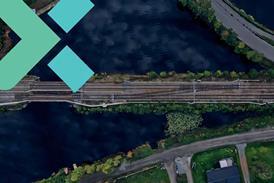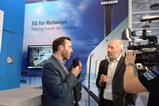
When the news broke that the critical mainline rail communications technology, GSM-R, was to be replaced starting around 2025, we at Ericsson knew this was the perfect opportunity to establish 5G as an evolutionary enabler of the nation’s railways.
Work is already underway on a new communications framework, the Future Railway Mobile Communication System. Defined by the International Union of Railways, the FRMCS will be based on 5G and can be complemented by 4G access. It is expected to be more open than GSM-R, which has been in place for the past two decades, thereby inviting innovation from third parties for further improved user experiences.
Increased passenger ridership with communication technologies
The FRMCS will use 3GPP standardization as the basis for a set of globally applicable technical specifications and designs for mobile networks. This is just one of the ways in which communications technologies are being explored to improve railway services and increase operational quality and efficiency.
Railway infrastructure managers, communication service providers, and railway application vendors are all beginning to adopt advanced new technologies designed to increase passenger and staff security, generate higher train speeds, and improve overall service punctuality.

Mainline railway operators are at the start of an exciting communications evolution with the following priorities:
- Improve critical connectivity: Critical train control applications require a higher level of performance, reliability, and safety than what is outside of the railway system.
- Increase security: A more capable network will provide security agencies access to real-time CCTV monitoring on-board the train and along the train tracks to ensure passenger safety and protect assets.
- Invest in and introduce new applications: Apply data analytics and advanced automation for efficiency gains and increased safety.
- Enable future-proof broadband services: Migrate GSM-R technology to 5G for FRMCS.
All of these improvements are expected to increase worldwide passenger ridership beyond current and even pre-pandemic levels, which also contributes to a reducing environmental impact. By increasing passenger ridership and reducing use of cars, taxis and busses, we promote the use of one of the cleanest forms of traveling – with many trains in Europe already powered by renewable sources of energy.
At the same time, railway operators are expected to improve operational efficiency through more effective measures made available to them to locate trains, monitor on-board systems, track cargo, and inform customers. All these features further improve service-delivery transparency and lower operational expenditure. The door is expected to open to new use cases specific to the global railway industry. These include driverless trains, virtual coupling, inspection of rail tracks using drones, and data analysis using artificial intelligence.
Let’s get technical for a moment
As of today, the current GSM-R system supports around 30 different handsets, while 4G-enabled Long Term Evolution, or LTE, and 5G support around 3,000 devices. By adopting 3GPP standardization for critical communications, both the railway industry and passengers will benefit from a much wider ecosystem of services, with plenty of standardized modules and devices.
Migrating to a wider ecosystem is expected to facilitate the introduction of affordable and vendor-agnostic solutions with easier service migration. The railway industry will benefit from the availability of innovation and technology development from the 3GPP consumer-services domain. Considering the cross-border nature of rail operations, combined with mission-critical performance requirements, it is especially beneficial to leverage the innovation and experience from the automotive sector for providing smooth and highly reliable connectivity during border crossings.
Once the new network infrastructure is in place, railway operators will be able to enable faster and safer train journeys. High-speed trains, such as those in use in Europe, travel at up to 350 km/hour and there are plans to increase this to 500 km/hour. To make this happen, more sensors and mobile devices will be needed on-board the trains and the tracks supported by Internet of Things, or IoT, and 5G technologies for tighter degrees of control. Currently, all high-speed trains in Japan use Ericsson networks for passenger connectivity on trains travelling at speeds above 350 km/hour.
Shaping the future of the railways through collaboration
Ericsson is involved in trials of multiple-input and multiple-output, or MIMO, radio network equipment in the FRMCS-allocated spectrum bands with major railway operators. Service providers have used Ericsson 5G radios to demonstrate direct passenger connectivity on trains with throughputs exceeding 1 Gbps in more than 200 repetitive tests. Railway signaling vendors have started to test the interworking of their signaling applications with Ericsson 4G and 5G core and access networks.
In addition, we have been collaborating with leading service providers and railway operators for several years to harness public mobile networks in a bid to improve on-board customer experiences.
Ericsson has been participating in standard development by the FRMCS and the European Telecommunications Standards Institute since 2015. Following what has been specified in 3GPP Release 16 and 17, which form the base for FRMCS standardization, the Ericsson Radio System portfolio has been developed to meet future railway communication requirements. Our rich 5G feature set in Radio Access Networks is designed to provide railways with superior network speeds and performance in FRMCS.
Our experts in network design services are experienced to identify the optimal infrastructure layout for the best positioning of 5G sites – while balancing coverage, capacity and cost – for the network to deliver critical communications for railway operations and seamless passenger experiences. We also factor in the latest rail innovations, such as radio-frequency windows, for the best total cost of ownership and performance. Radio-frequency windows allow 5G radio waves to circulate better than traditional glass to provide much-needed passenger connectivity without the need of traditional repeater antennas, which are expensive to maintain and expand for higher capacities. Network design is the foundation for directly shaping network performance and reliability, as well as its potential for future expansion.
Close to 100 live 5G networks across five continents
Ericsson is well positioned to leverage its long experience in the telecom industry to benefit railway operators. As of late August 2021, Ericsson powers close to 100 live 5G networks across five continents – more than any other vendor. All these networks use Ericsson Radio, Ericsson Core, or both. Our leading 5G capabilities can be found in accurate positioning, mission-critical small dual mode Core, macro antenna system, and indoor coverage solutions for stations and tunnels.
We use our leading 5G technology, 3GPP-based mission-critical services, and strategy for partnering with on-board device vendors, to provide end-to-end connectivity solutions that support voice, data, and video services. Our goal is to help railway operators achieve high levels of reliability and availability for critical communications with 5G for FRMCS – all for the smoothest possible digital transformation journeys.
Read more about future connectivity technology and use cases for railway.
Read more about why railway communications need great network design.
Explore the operational and technical aspects for migrating to mission-critical 4G and 5G services.

Author: David Rothbaum,
Global Business Development Director, Ericsson Mission Critical Networks






















